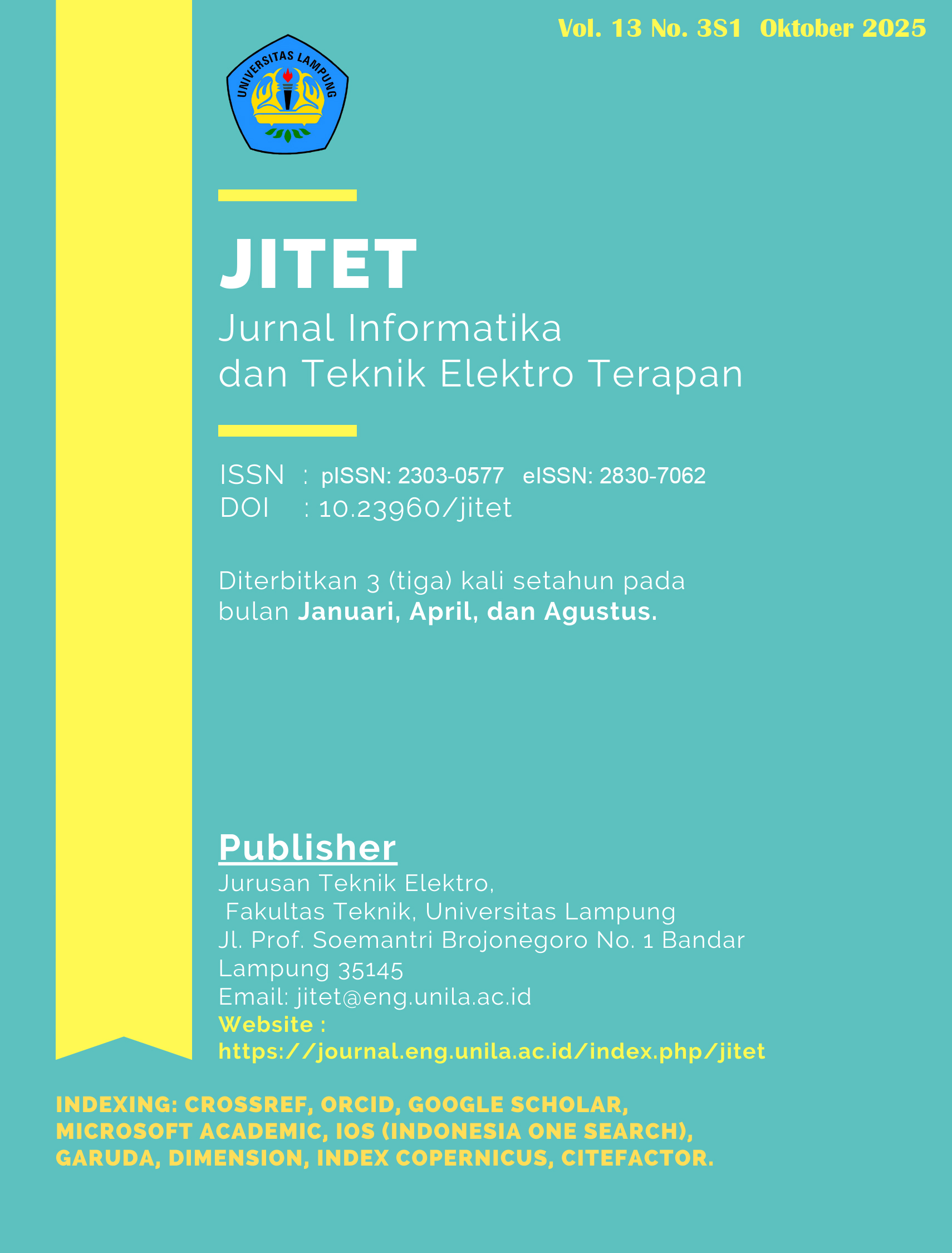EVALUATION OF MALANG CITY'S ENVIRONMENTAL QUALITY BASED ON IOT DATA USING MCDM
DOI:
https://doi.org/10.23960/jitet.v13i3S1.8187Abstract Views: 0 File Views: 0
Keywords:
Environmental evaluation, IoT, MCDM, MOORA, SAW, Pollution ZoneAbstract
Malang City is one of the major cities in East Java with a high population. Based on the IoT data on the correlation between the number of vehicles and air quality in Malang City, this study evaluated the environmental quality with several criteria, including humidity, temperature, dust particulates, CO2, CO, and noise. The criteria data were assessed through MCDM methods, namely MOORA and SAW. These methods are very effective in determining the condition of pollution-prone zones from the lowest to the highest environmental quality locations through the resulting ranking. Through the MOORA method, Point 1: Jl. Raya Tlogomas, Tanggul Mas is the area that has the lowest MOORA score with a value of -0.364 and SAW score with a value of 0,808, which indicates that the area has the least conducive environmental quality. This study provides vital information for the awareness of the community and related parties to minimize the health effects caused.
Downloads
References
I. Wellid et al., “Evaluasi Polusi Udara PM2.5 dan PM10 di Kota Bandung serta Kaitannya dengan Infeksi Saluran Pernafasan Akut,” Jurnal Kesehatan Lingkungan Indonesia, vol. 23, no. 2, pp. 128–136, Jun. 2024, doi: 10.14710/jkli.23.2.128-136.
I. Hamzah, F. Lihawa, and S. Maryati, “Analisis Hubungan Jumlah Kendaraan Dan Konsentrasi Karbon Monoksida (CO) Di Kota Gorontalo, Provinsi Gorontalo,” Dampak, vol. 19, no. 1, pp. 40–49, Nov. 2023, doi: 10.25077/dampak.19.1.40-49.2022.
F. D. Hanggara, Aulia Fikriarini M., Allin Junikhah, Yasmin Zafirah, and Fariz Rifqi Zul Fahmi, “Correlation of Vehicle Traffic to Air Quality, Temperature, and Noise in Malang City Through an Internet of Things (IoT) Approach,” Jurnal Nasional Teknik Elektro, pp. 144–152, Nov. 2024, doi: 10.25077/jnte.v13n3.1259.2024.
Ismiyati, D. Marlita, and D. Saidah, “Pencemaran Udara Akibat Emisi Gas Buang Kendaraan Bermotor,” Jurnal Manajemen Transportasi & Logistik (JMTransLog), vol. 01, no. 03, 2014.
R. Wirosoedarmo, B. Suharto, and D. E. Proborini, “Analisis Pengaruh Jumlah Kendaraan Bermotor dan Kecepatan Angin Terhadap Karbon Monoksida di Terminal Arjosari,” Jurnal Sumberdaya Alam dan Lingkungan, vol. 7, no. 2, pp. 57–64, Aug. 2020, doi: 10.21776/ub.jsal.2020.007.02.2.
J. S. Alam, D. Lingkungan, B. Rahadi, E. Kurniati, and A. Tasya Imaya, “Analisis Sebaran Polutan SO2, NOx dan PM10 dari Sumber Bergerak pada Jalan Arteri Kota Malang Pollutant Distribution Analysis Of SO2, NOx And PM10 From Non Point Source On Arterial Roads In Malang City,” 2020.
W. Hadi et al., “KAJIAN BEBAN PENCEMARAN AIR SUNGAI DI KOTA MALANG DARI ASPEK KUALITAS AIR, ASPEK TATA GUNA LAHAN, DAN ASPEK KELEMBAGAAN,” 2021.
R. Zahro Hasibuan, A. Prahutama, and D. Ispriyanti, “PERBANDINGAN METODE MOORA DAN TOPSIS DALAM PENENTUAN PENERIMAAN SISWA BARU DENGAN PEMBOBOTAN ROC MENGGUNAKAN GUI MATLAB,” JURNAL GAUSSIAN, vol. 8, no. 4, pp. 462–473, 2019.
P. Indrayati Sijabat, J. H. Sianipar, R. Sibarani, and S. Pelita Nusantara, “Metode Moora Untuk Kelayakan Rekomendasi Kandidat Kepala Desa Di Jawa Maraja,” Digital Transformation Technology (Digitech) | e, vol. 3, no. 1, 2023, doi: 10.47709/digitech.v3i1.2670.
M. Br Hutahaean, R. Tamara Aldisa, S. Siregar, A. Mana Sikana, and E. Penulis Korespondensi, “KLIK: Kajian Ilmiah Informatika dan Komputer Penerapan Metode MOORA dan MOOSRA dalam Penentuan Kelayakan Nasabah Penerima Kredit,” Media Online, vol. 4, no. 3, pp. 1684–1691, 2023, doi: 10.30865/klik.v4i3.1434.
T. Shabrina and B. Sinaga, “Penerapan Metode MOORA pada Sistem Pendukung Keputusan untuk Menentukan Siswa Penerima Bantuan Miskin,” Jurnal Ilmu Komputer dan Bisnis, vol. 12, no. 2a, pp. 161–172, Dec. 2021, doi: 10.47927/jikb.v12i2a.214.
Try Kardina Unitama, A. Abdullah, and Istiqoma, “Penerapan MOORA dan SAW Dalam Sistem Pendukung Keputusan Pemilihan Petani Penerima Bantuan,” JUSTINDO (Jurnal Sistem dan Teknologi Informasi Indonesia), vol. 10, no. 1, pp. 20–30, Mar. 2025, doi: 10.32528/justindo.v10i1.2480.
Y. Rahmawati and S. Rohman Cholil, “Perbandingan Metode ARAS dan MOORA untuk Menentukan Santri Penerima Beasiswa Berprestasi,” Maret, vol. 7, no. 1, pp. 2622–4615, 2022, doi: 10.32493/informatika.v7i1.17485.
V. M. M. Siregar, M. A. Hanafiah, N. F. Siagian, K. Sinaga, and M. Yunus, “Decision Support System For Selecting The Best Practical Work Students Using MOORA Method,” Internet of Things and Artificial Intelligence Journal, vol. 2, no. 4, pp. 270–278, Nov. 2022, doi: 10.31763/iota.v2i4.562.
D. Eka Setyowati et al., “Implementasi Metode Moora Untuk Sistem Pendukung Keputusan Pemilihan Sales Terbaik Pada PD Anugrah Abadi Baru,” 2023.
I. Al Khoiry, R. Gernowo, and B. Surarso, “Fuzzy-ahp moora approach for vendor selection applications,” Register: Jurnal Ilmiah Teknologi Sistem Informasi, vol. 8, no. 1, pp. 24–37, 2022, doi: 10.26594/REGISTER.V8I1.2356.
M. Solikin, P. Eka Suryani, D. Purnomo Putro, U. Safin Pati, J. Raya Pati -Tayu NoKm, and J. Tengah DOI, “Information Science and Library Komparasi Metode MAUT, WASPAS, MOORA, Fuzzy AHP, TOPSIS dalam Seleksi Penerima Beasiswa,” 2025. [Online]. Available: http://journals.usm.ac.id/index.php/jisl
N. Nurhaliza and R. Adha, “PERBANDINGAN METODE AHP, TOPSIS, DAN MOORA UNTUK REKOMENDASI PENERIMA BEASISWA KURANG MAMPU,” Jurnal Ilmiah Rekayasa dan Manajemen Sistem Informasi, vol. 8, no. 1, pp. 23–30, 2022.
R. Singh et al., “A historical review and analysis on MOORA and its fuzzy extensions for different applications,” Heliyon, vol. 10, no. 3, Feb. 2024, doi: 10.1016/j.heliyon.2024.e25453.
D. Nofriansyah and S. Defit, Multi Criteria Decision Making (MCDM) pada Sistem Pendukung Keputusan. Deepublish, 2017.
Downloads
Published
How to Cite
Issue
Section
License
Copyright (c) 2025 Jurnal Informatika dan Teknik Elektro Terapan

This work is licensed under a Creative Commons Attribution-NonCommercial 4.0 International License.





